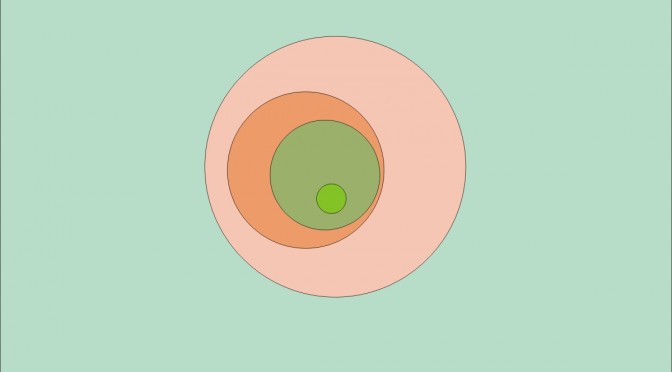We consider a decreasing sequence \((C_n)_{n \in \mathbb{N}}\) of non empty closed convex subsets of a Banach space \(E\).
If the convex subsets are closed balls, their intersection is not empty. To see this let \(x_n\) be the center and \(r_n > 0\) the radius of the ball \(C_n\). For \(0 \leq n < m\) we have \(\Vert x_m-x_n\Vert \leq r_n – r_m\) which proves that \((x_n)_{n \in \mathbb{N}}\) is a Cauchy sequence. As the space \(E\) is Banach, \((x_n)_{n \in \mathbb{N}}\) converges to a limit \(x\) and \(x \in \bigcap_{n=0}^{+\infty} C_n\).
We’ll see that \(\bigcap_{n=0}^{+\infty} C_n\) can be empty even in the case where \(d = \sup_n d(0,C_n)\) is finite. Note: when \(\sup_n d(0,C_n)\) is infinite, \(\bigcap_{n=0}^{+\infty} C_n\) can be empty, i.e. if \(C_n=[n \cdot u, +\infty \cdot u )\) where \(u \in E \setminus \{0\}\).
Let \(E\) be the set of real continuous functions defined on \([0,1]\) and \((r_n)_{n \in \mathbb{N}}\) an enumeration of the rational numbers of \([0,1]\). Let \(B=\{f \in E ; \Vert f \Vert \leq 2\}\) and \(C=\{f \in E ; \int_0^1 f = 1\}\). We take \(C_n=B \bigcap C \bigcap \{f \in E ; f(r_0)=f(r_1)= \dots =f(r_n)=0\}\). For all \(n \in \mathbb{N}\), \(C_n\) is convex as it is the intersection of convex subsets of \(E\). \(C_n\) is not empty. To see this, let’s note \(q_0=0 < q_1 < q_2 < \dots < q_m =1\) the set \(\{0,1, r_0,r_1, \dots r_n\}\) of rational numbers and \(f_n\) the piecewise affine function such that \(f_n(q_i)=0\) for \(0 \leq i \leq m\) and \(f_n(q^\prime_j)=2\) where \(q^\prime_j\) is arbitrarily chosen in \((q_j,q_{j+1})\) for \(0 \leq j \leq m-1\). \(f_n \in C_n\) as \(\int_0^1 f = 1\). However, \(\bigcap_{n=0}^{+\infty} C_n\) is empty as a function \(f\) in the intersection has to vanish at all rational of \([0,1]\). Consequently, \(f\) is the zero function, contradicting the requirement \(\int_0^1 f = 1\).
If \((E,\Vert \cdot \Vert)\) is uniformly convex (in particular if \(E\) is a Hilbert space) and \(d = \sup_n d(0,C_n)\) is finite, then \(\bigcap_{n=0}^{+\infty} C_n\) cannot be empty. For the proof, let \(P_n=C_n \cap B(0, d+1/n)\). \((P_n)\) is a decreasing sequence of nonempty closed sets. We claim that \(\lim\limits_{n \rightarrow \infty} \delta(P_n)=0\), where \(\delta(P_n)\) denotes the diameter of the set \(P_n\). Indeed, for any \(n\), let \(x_n\) and \(y_n\) be arbitrary points in \(P_n\). Since \(P_n\) is convex, the point \((x_n+y_n)/2\) lies in \(P_n\), so the values \(\Vert x_n \Vert\), \(\Vert y_n \Vert\), and \(\frac{1}{2} \Vert x_n + y_n \Vert\) are between \(d + 1/n\) and \(d(0,C_n)\), and therefore the three sequences converge to \(d\) as \(C_n\) is a decreasing sequence of sets. Because the norm \(\Vert \cdot \Vert\) is uniformly convex, we infer that \(\Vert x_n – y_n \Vert \rightarrow 0\), and consequently \(\lim\limits_{n \rightarrow \infty} \delta(P_n)=0\). \((P_n)\) is a decreasing sequence of nonempty closed sets of diameters converging to \(0\) in a Banach space, so \(\bigcap_{n=0}^{+\infty} P_n\) is nonempty and therefore \(\bigcap_{n=0}^{+\infty} C_n\) is also nonempty.

